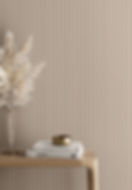Shaping the interiors of 2025 with Fluted Design
- Sonal Silva
- Jun 2
- 3 min read

Fluted design is taking centre stage in 2025, emerging as a standout feature across architecture, furniture, and even product design. Characterised by its elegant vertical grooves, fluting is being used to add texture, depth, and refinement to spaces of all kinds. It’s a trend that feels fresh yet timeless. A nod to classical design, reimagined for modern living.
Fluting is making appearances just about everywhere this year. Accent walls with fluted panels are adding dimension to living rooms, bedrooms, and commercial spaces. Kitchen cupboards and wardrobe doors are stepping away from flat finishes in favour of ribbed detailing. Bathroom vanities and even bathtubs are being crafted with fluted exteriors that look like sculptural pieces in their own right.
The trend extends to furniture, think sideboards, bar counters, and even bed frames, as well as to lighting fixtures, mirror frames, and home décor accessories like vases and planters. Exterior cladding is another exciting development, with architects using fluted concrete, timber, and metal panels to give facades rhythm and structure.
Depth through detail

At its core, fluted design is about elevating flat surfaces into something more sculptural and dynamic. The repetitive vertical lines which add visual rhythm are being embraced across a variety of materials, including wood, stone, metal, concrete, and glass, proving its versatility. Whether used on a timber cabinet in a minimalist kitchen, a bathroom vanity, or a ribbed concrete wall in a commercial lobby, the effect is the same; visual interest without overwhelming the eye. The subtle play of shadow and light across these grooves creates a sense of depth that brings a space to life. It's an effortless way to make interiors feel richer, more dynamic, and considered.
Versatility across style
What makes fluting particularly appealing is its adaptability. It seamlessly integrates into a wide range of interior styles. In pared-down, contemporary homes, fluted finishes add just the right amount of softness and sophistication, while in more eclectic or luxurious spaces, they complement ornate features with a sense of refinement. The look feels sculptural and tactile, qualities that are increasingly valued in today’s design landscape where people crave a deeper sensory connection with their surroundings.

Function meets form
Fluted design isn’t just visually appealing, it’s practical too. In cabinetry, the grooves offer better grip and tactile interest. On wall panels, they can help with acoustic dampening.

In lighting, fluted glass or metal adds both ornamentation and texture, subtly changing how light diffuses through a space. The combination of beauty and functionality is one of the reasons this design detail is being embraced so widely, from large-scale architecture to everyday objects.
Timeless appeal with a modern twist
Although fluting is rooted in classical design, its latest evolution feels anything but old-fashioned. By pairing traditional craftsmanship with modern materials and clean lines, fluted details offer a refined yet contemporary vibe. It's a design language that communicates elegance and intentionality, and one that resonates deeply in today’s interiors, where people are seeking both style and substance.

How to incorporate Fluted Design into your space
Start small: A fluted vase or a side table can introduce the look without a major commitment.
Go bold: Install a fluted accent wall or opt for a statement fluted bathtub.
Mix materials: Combine fluted wood with smooth stone or matte finishes for modern contrast.
Layer textures: Pair fluted surfaces with soft textiles and flat finishes to create depth and balance.

Whether you're looking to make a bold statement with a fluted feature wall or introduce the look through subtle accessories, this trend offers endless possibilities. As we continue to prioritise texture, tactility, and thoughtful design, fluted surfaces are proving they’re here to stay. A modern classic in the making.


